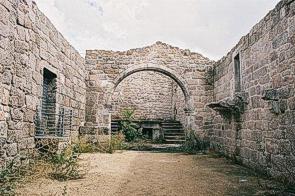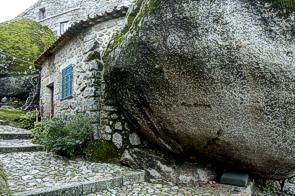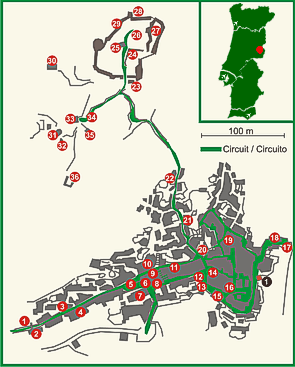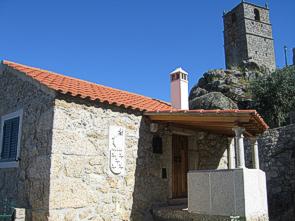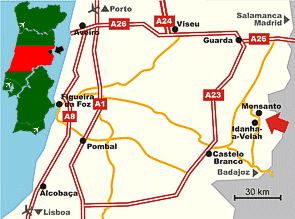
Distances
Idanha-a-Velha - 12 km
Castelo Branco - 42 km
Guarda - 42 km
Porto - 176 km
Lisbon - 258 km
Salamanca - 158 km
Madrid - 366 km
Badajoz - 74 km
Monsanto was voted in 1938 the "most Portuguese village in Portugal" nestles on the slope of a steep hill (the Monsanto head, known in Latin as Mons Sanctus), which rises abruptly above the prairy and reaches a height of 758 meters (2486 feet).
The most typical aspect of Monsanto is the fact that the village developed around impressively big and miraculously balanced granitic boulders.
One of the most symbolic traditions of Monsanto is the Festival of the Holy Cross, held on the 3rd of May, to commemorate the resistance to a long history of sieges: the women carry to the top of the castle typical rag-dolls (known as "marafonas") and clay jars full of flowers are thrown from the walls.
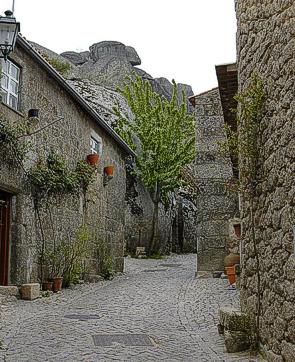
Monsanto stands in the Northeast side of Idanha Lands, nestled on a steep hill slope - Monsanto hillock (Mons Sanctus), which abruptly rises out of the prairie and reaches758 meters on its highest point. There are several hamlets scattered along the several slopes and at the bottom of the hill, which shows the population movements towards the plain. It's a very ancient place with evidence of human presence since the Paleolithic Era. They found archaeological evidence of a Lusitanian fortress and of Roman occupation in St. Laurence's field, at the foot of the hill, as well as of Visigoth and Arabian occupation. King Afonso Henriques conquered Monsanto from the Moors and, in 1165, granted it to the Templar monks who had the Castle built under the orders of Gualdim Pais. King Afonso Henriques first chartered the village in 1174 and then King Sancho I (1190) and King Afonso III (1217) confirmed the Charter. King Sancho I rebuilt and repopulated the fortress, which had been destroyed during the fights against the king of Leão. In 1308, King Dinis granted it a Charter, which allowed a fair to take place near the Chapel of São Pedro de Vir-a-Corça. King Manuel I granted it a New Charter in 1510, giving it the right to be a Town.
In the middle of the 17th century, Luis de Haro, Minister for Filipe IV, tried to siege Monsanto, but he had no success. Later on, in the beginnings of the 18th century, the Duke of Berwick also laid siege to Monsanto but the Portuguese Army, commanded by the Marquis of Minas, defeated the invader on the slopes of the hill. In 1758, Monsanto was a municipality, having kept this privilege untill 1853. In the 19th Century, the imposing Castle of Monsanto was partly destroyed by the accidental explosion of the munitions storeroom.
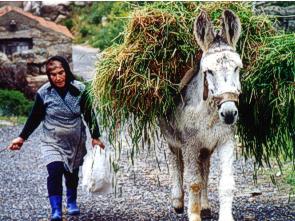
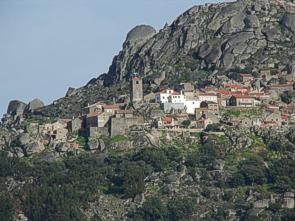
(Click on Map to Enlarge)
Before coming in to Monsanto you can admire the magnificent landscape that is offered to you from the bulwark, which is used as a parking area nowadays.
A few steps ahead, you will find the Mother Church ![]() . It was probably built in the 15th century and restored in the 18th century, but it still keeps its older elements, such as a roman doorway. Inside you can admire the beautiful images and altars, specially the high alter with magnificent gold leaf work. Head to the Pillory Square via Rua da Capela (Chapel St.) where you will find the Antiga Aldeia (Old Wine Cellar)
. It was probably built in the 15th century and restored in the 18th century, but it still keeps its older elements, such as a roman doorway. Inside you can admire the beautiful images and altars, specially the high alter with magnificent gold leaf work. Head to the Pillory Square via Rua da Capela (Chapel St.) where you will find the Antiga Aldeia (Old Wine Cellar) ![]() and the Pousada de Monsanto
and the Pousada de Monsanto ![]() . The Square where you find the Pillory
. The Square where you find the Pillory ![]() , Antiga Capela do Soccorro
, Antiga Capela do Soccorro ![]() and Igreja da Misericódia (Mercy Church)
and Igreja da Misericódia (Mercy Church) ![]() is also called Mercy Square. Showing essentially Roman features, the Mercy Church has some restoration work done. Climb up to the Torre do Relógio (Clock Tower)
is also called Mercy Square. Showing essentially Roman features, the Mercy Church has some restoration work done. Climb up to the Torre do Relógio (Clock Tower) ![]() . At the top you can see a copy of the silver clock, a symbol of the award - The most Portuguese Village of Portugal - attributed to Monsanto. Sit on the benches and enjoy the gorgeous view over Idanha plain. Return to the Mercy Church following through the back streets, then turn down Rua do Relógio (Clock St,) to the Chapel
. At the top you can see a copy of the silver clock, a symbol of the award - The most Portuguese Village of Portugal - attributed to Monsanto. Sit on the benches and enjoy the gorgeous view over Idanha plain. Return to the Mercy Church following through the back streets, then turn down Rua do Relógio (Clock St,) to the Chapel ![]() (dating from 16th century, with a Gothic vaulted High Chapel) and to St. António's Gate
(dating from 16th century, with a Gothic vaulted High Chapel) and to St. António's Gate ![]() .
.
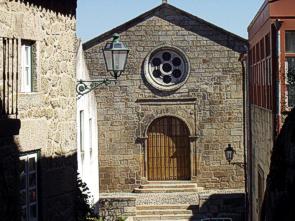
Turn right through Santo Antonio St. and Barreira Quebrada St., and go up to Fonte do Ferreiro (Blacksmith Fountain) where a small ceramic plaque says: " The water of this spring quenched many unknown heroes' thirst". Climb up on the right, in front of house number 13, following the Castle direction. On the way you will find a Gruta (Cave) ![]() and, near the Forno Comunitário (Communial Oven)
and, near the Forno Comunitário (Communial Oven) ![]() , there ia a natural belvedere which overlooks the prairie and the village houses scattered down the slopes. Walk up the Rua do Castelo (Castle St.). The old Monsanto fortress has 2 doorways: Porta da Traição (Betrayal Door)
, there ia a natural belvedere which overlooks the prairie and the village houses scattered down the slopes. Walk up the Rua do Castelo (Castle St.). The old Monsanto fortress has 2 doorways: Porta da Traição (Betrayal Door) ![]() and the main entrance. The latter, sited near Casa do Guarda (Sentry House)
and the main entrance. The latter, sited near Casa do Guarda (Sentry House) ![]() , is an L shape with vaulted arches. The Castle, like the village, shows adaptations to the ground unevenness. The Cistern
, is an L shape with vaulted arches. The Castle, like the village, shows adaptations to the ground unevenness. The Cistern ![]() is inside the Castle walls, in the middle of a polygon limited by the Keep
is inside the Castle walls, in the middle of a polygon limited by the Keep ![]() , the Governors' House
, the Governors' House ![]() and the St. Maria do Castelo Church
and the St. Maria do Castelo Church ![]() . The latter was rebuilt on a former religious building belonging to Templar Monks. In May, the church holds the Feast of the Holy Cross.
. The latter was rebuilt on a former religious building belonging to Templar Monks. In May, the church holds the Feast of the Holy Cross.
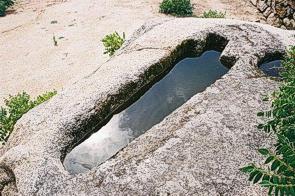
Outside the walls you will find Capela de São João (St. Johns Chapel) ![]() , of which only one arch near the wall remains, and Capela de São Miguel (St. Michael's Church)
, of which only one arch near the wall remains, and Capela de São Miguel (St. Michael's Church) ![]() . The latter is a Roman building, erected in the 12th/13th centuries and has some graves excavated in the rock
. The latter is a Roman building, erected in the 12th/13th centuries and has some graves excavated in the rock ![]() . In the 16th Century, the temple was in the center of the village. Outside the walls, you can see evidence of Torre do Pião (Pin Tower), a watch point in the middle ages. Head down Santa Maria do Castelo St. on the corner, stands the house where Fernando Namora worked as a doctor. Follow up to the left to the belvedere and walk down to Lucano's Tower
. In the 16th Century, the temple was in the center of the village. Outside the walls, you can see evidence of Torre do Pião (Pin Tower), a watch point in the middle ages. Head down Santa Maria do Castelo St. on the corner, stands the house where Fernando Namora worked as a doctor. Follow up to the left to the belvedere and walk down to Lucano's Tower ![]() . Before reaching the Tower, turn right to a small street that leads to the Pillory Square, turn left to Marquês da Graciosa St. where you find the Solar (Manor House)
. Before reaching the Tower, turn right to a small street that leads to the Pillory Square, turn left to Marquês da Graciosa St. where you find the Solar (Manor House) ![]() , from the 18th century, which belonged to Giraldes de Andrade, Governor of Monsanto, it now houses the tourist office.
, from the 18th century, which belonged to Giraldes de Andrade, Governor of Monsanto, it now houses the tourist office.

Pinheiro Family's Manor House ![]() dates from the 18th century. It is sited in Marquês da Graciosa St. and hold Mono's Fountain
dates from the 18th century. It is sited in Marquês da Graciosa St. and hold Mono's Fountain ![]() on its facade. Behind the Monsanto Inn, reach Largo do Cruzeiro (Cross Square)
on its facade. Behind the Monsanto Inn, reach Largo do Cruzeiro (Cross Square) ![]() . The Chafariz da Fonte Nova (New Fountain)
. The Chafariz da Fonte Nova (New Fountain) ![]() stands near the stone cross, which gives name to the Square. Walking down Fernando Namora St., you will find the house
stands near the stone cross, which gives name to the Square. Walking down Fernando Namora St., you will find the house ![]() where the writer and doctor lived. It's near the Chafariz do Meio (Middle Fountain)
where the writer and doctor lived. It's near the Chafariz do Meio (Middle Fountain) ![]() . The Capela do Espirito Santo (Holy Ghost Chapel)
. The Capela do Espirito Santo (Holy Ghost Chapel) ![]() , in Renaissance style stands a few steps way. Showing a small bell tower, was erected in the 16th century, backed to one of the village gates: Arco de São Sebastião ou do Espirito Santo ( St. Sebastian or Holy Ghost Arch
, in Renaissance style stands a few steps way. Showing a small bell tower, was erected in the 16th century, backed to one of the village gates: Arco de São Sebastião ou do Espirito Santo ( St. Sebastian or Holy Ghost Arch ![]() , which is near the sentry box.
, which is near the sentry box.
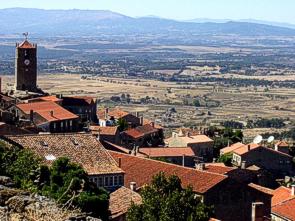
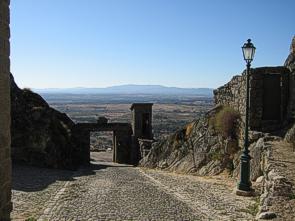
Lion House (Casa de Leão - Selfcatering)
The house is located inside the walls of Monsanto. This is an exclusive and luxurious antique house, decorated with original 18th century furniture. The house has a Bedroom, living room, dining room/single bedroom, bathroom and kitchen. There are splendid view from the windows. Capacity: 2 - 3 Persons.
Cave House (Casa da Gruta - Selfcatering)
A stunning rustic stone house located inside the walls of Monsanto. It has a double bedroom and a bathroom and is decorated with original 17th century furniture.
Capacity: 2 Persons.
Restaurants
- Café Monsantino: Rua do Castelo, 4. Tel: 277 314 493
- Restaurant Pousada de Monsanto: Monsanto. Tel: 277 314 471/2
- Restaurant Petiscos e Granitos: Rua do Castelo, 15. Tel: 964 200 974
- Restaurant O Jovem: Tel: 277 314 590
- Adega O Cruzeiro: Tel: 277 314 528
Markets and Feasts
- Town market 3rd Saturday of each month
- Festa de Nossa Senhora do Castelo ou das Cruzes - 3rd May or nearest Sunday,
- Festa em Honra de São Sebastião - 1st weekend in September
- Festa em Honra de Nossa Senhora da Azenha - 2nd weekend in September
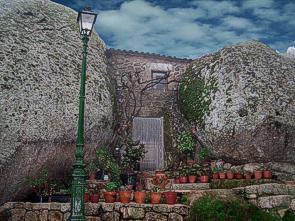
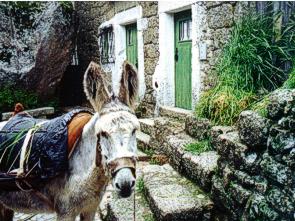
Services
- Tourist Office: Rua Marquês da Graciosa. Tel: 277 314 642. Opening times: 10am - 1pm / 2pm - 6pm
- Administrative Office: Monsanto. Tel: 277 314 439
- Pharmacy: Rua da Capela, 4. Tel: 277 314 189
- Health Center: Laugar da Misericordia. Tel: 277 314 183
- Post Office: Largo do Cruzeiro, 1A. Tel: 277 314 156. Opening times: 9am - Noon
- Public Phone: Rua do Castelo, 1. Tel: 277 314 213
- Grocer's: Largo da Misericordia, 3A. Tel: 277 314 213
Handcraft Shops
- Rua do Castelo, 6. Tel: 277 314 151
- Rua da Capela, 8. Tel: 277 314 102
- Rua Marquês da Graciosa, 11. Tel: 277 314 183
- Rua do Castelo, 25. Tel: 962 789 740
- Rua Marquês da Graciosa, 12. Tel: 967 987 720
